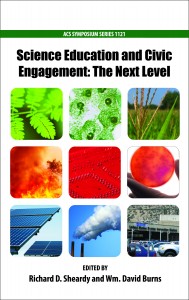 Science Education and Civic Engagement: The Next Level is the most recent publication on SENCER released by the American Chemical Society Symposium Series. The new volume was published on line at the very end of 2012 and will be available in book form later this spring. The new book builds upon and expands the strategies and examples developed in Science Education and Civic Engagement: The SENCER Approach, published in 2010.
Science Education and Civic Engagement: The Next Level is the most recent publication on SENCER released by the American Chemical Society Symposium Series. The new volume was published on line at the very end of 2012 and will be available in book form later this spring. The new book builds upon and expands the strategies and examples developed in Science Education and Civic Engagement: The SENCER Approach, published in 2010.
Science Education and Civic Engagement: The Next Level contains contributions by many scholars and practitioners known to the SENCER community and some relative newcomers, as well. It was edited by Richard D. Sheardy of Texas Woman’s University and Wm. David Burns. The chapter titles and their authors are listed below. The book may be found here.
Meeting the Challenges of Large Scale Educational Reform: SENCER and the Problem of “Knowledge Inequality” – Wm. David Burns
Incorporating an Environmental Research Project Across Three STEM Courses: A Collaboration between Ecology, Organic Chemistry, and Analytical Chemistry Students – Douglas E. Latch, W. Lindsay Whitlow, and Peter J. Alaimo
Weaving a Tapestry of Change: Implementing SENCER on Campus – DonnaJean A. Fredeen
How To Build a Transdisciplinary Certificate – Jeffrey B. Robb and Richard D. Sheardy
Teaching and Learning on Radioactive Landscapes: Nuclear Unclear – Cathy Middlecamp
Connecting Head, Hand, and Heart: SENCER and Becoming a Chemist – Matthew A. Fisher
Bringing SENCER’s Civic Engagement Strengths to Large Research Universities: A “Trojan Horse” Hybrid Model To Initiate Incremental Course Reform – Garon C. Smith
Stop, Look, Listen: Making a Difference in the Way Future Teachers Think About Science and Teaching – Carolyn M. Viviano, Maria R. Alderete, Catie Boarts, and Meredith McCarthy
Formal/Informal Science Learning through Civic Engagement: Both Sides of the Education Equation – Alan J. Friedman and Ellen F. Mappen
SENCER and the Dual Poster Concept: Translating Science into Common Language – Le Shepard, Nicole Wallis, and Cynthia Maguire
Disseminating Curricular Models: Bringing SENCER to the Next Level – Eliza Jane Reilly
STEM Practice and Assessment: SENCER’s Influence on Educators – Danielle Kraus Tarka and Janice Ballou
Using the SENCER-SALG To Reveal Student Learning in a Large-Scale Environmental Chemistry Course for Non-Majors – Trace Jordan
The Importance of Interface: A Tale of Two Sites – Stephen B. Carroll
Applying the Innovation Diffusion Model to SENCERizing the Curriculum: Has SENCER Crossed the Chasm? – Amy M. Shachter and Jon J. Barnett
